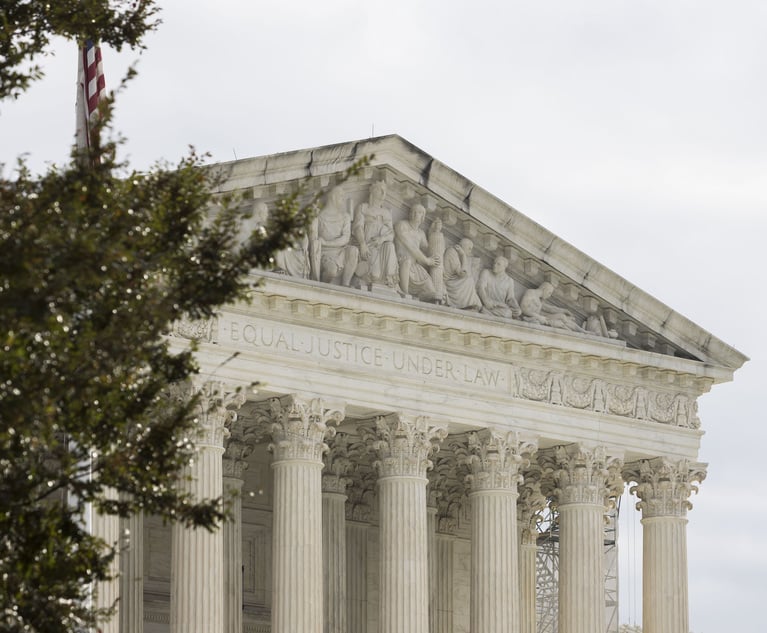In Age of Twitter, Do Investors Need Instant Updates?
Gregg Weiner of Ropes & Gray writes: The U.S. Supreme Court will review a ruling from the Second Circuit in 'Leidos', holding that Item 303 creates a duty to disclose that can subject companies to civil liabilities for securities fraud under §10(b). A ruling by the high court, expected to come in the October 2017 term, could significantly impact the scope of potential liability for nondisclosures under §10(b) and change the disclosure practices of public companies.
July 12, 2017 at 02:02 PM
12 minute read
We live in the age of instant communication. But the long-standing rule under the federal securities laws is that “[s]ilence, absent a duty to disclose, is not misleading.” Basic v. Levinson, 485 U.S. 224, 239 n.17 (1988). Item 303 of SEC Regulation S-K requires that public companies disclose “any known trends and uncertainties” that have or will have a material impact on the business in public filings. There is no doubt that a violation of Item 303 can give rise to liability under the Securities Act of 1933, which allows civil lawsuits when a registration statement filed in connection with a public offering “omit[s] to state a material fact required to be stated therein.” What is less clear, however, is whether a violation of Item 303 can give rise to liability under §10(b) of the Securities and Exchange Act of 1934, which, pursuant to Rule 10b-5, makes it unlawful to “make any untrue statement of a material fact” or to “omit to state a material fact necessary in order to make the statements made … not misleading” in connection with the purchase or sale of securities. The U.S. Supreme Court will decide the issue when it reviews a ruling from the Court of Appeals for the Second Circuit in Leidos v. Indiana Public Retirement System, holding that Item 303 creates a duty to disclose that can subject companies to civil liabilities for securities fraud under §10(b). A ruling by the high court, expected to come in the October 2017 term, could significantly impact the scope of potential liability for nondisclosures under §10(b) and change the disclosure practices of public companies.
Section 10(b) and Item 303
Section 10(b) of the Securities Exchange Act of 1934, through its implementing regulation, Rule 10b-5, makes it unlawful for any person to “make any untrue statement of a material fact” or to “omit to state a material fact necessary in order to make the statements made … not misleading” in connection with the purchase or sale of securities. 17 C.F.R. §240.10b-5. Neither §10(b) nor Rule 10b-5 expressly contemplate liability for omissions where no statement has been made at all—that is, when the speaker in question has remained silent on a particular subject. Thus, the Supreme Court had long held that “[s]ilence, absent a duty to disclose, is not misleading” and therefore does not give rise to liability under §10(b). Basic, 485 U.S. at 239 n. 17. As the Supreme Court has recognized, this allows public companies to “control what they have to disclose” under §10(b) “by controlling what they say to the market.” Matrixx Initiatives v. Siracusano, 563 U.S. 27, 45 (2011).
Item 303 is an SEC disclosure rule that requires companies to disclose “any known trends or uncertainties” that have or will have a material impact on “net sales or revenues or income from continuing operations.” 17 C.F.R. §229.303(a)(3)(ii) (2017). The SEC has explained that management should engage in the following process when evaluating trends or uncertainties under Item 303:
• First, determine whether the trend or uncertainty is “likely to come to fruition.” If management determines the trend or uncertainty is not “reasonably likely to occur,” then disclosure is not required.
This content has been archived. It is available through our partners, LexisNexis® and Bloomberg Law.
To view this content, please continue to their sites.
Not a Lexis Subscriber?
Subscribe Now
Not a Bloomberg Law Subscriber?
Subscribe Now
NOT FOR REPRINT
© 2025 ALM Global, LLC, All Rights Reserved. Request academic re-use from www.copyright.com. All other uses, submit a request to [email protected]. For more information visit Asset & Logo Licensing.
You Might Like
View All


Class Certification, Cash-Sweep Cases Among Securities Litigation Trends to Watch in 2025
6 minute read
Trending Stories
- 1Decision of the Day: Judge Dismisses Defamation Suit by New York Philharmonic Oboist Accused of Sexual Misconduct
- 2California Court Denies Apple's Motion to Strike Allegations in Gender Bias Class Action
- 3US DOJ Threatens to Prosecute Local Officials Who Don't Aid Immigration Enforcement
- 4Kirkland Is Entering a New Market. Will Its Rates Get a Warm Welcome?
- 5African Law Firm Investigated Over ‘AI-Generated’ Case References
Who Got The Work
J. Brugh Lower of Gibbons has entered an appearance for industrial equipment supplier Devco Corporation in a pending trademark infringement lawsuit. The suit, accusing the defendant of selling knock-off Graco products, was filed Dec. 18 in New Jersey District Court by Rivkin Radler on behalf of Graco Inc. and Graco Minnesota. The case, assigned to U.S. District Judge Zahid N. Quraishi, is 3:24-cv-11294, Graco Inc. et al v. Devco Corporation.
Who Got The Work
Rebecca Maller-Stein and Kent A. Yalowitz of Arnold & Porter Kaye Scholer have entered their appearances for Hanaco Venture Capital and its executives, Lior Prosor and David Frankel, in a pending securities lawsuit. The action, filed on Dec. 24 in New York Southern District Court by Zell, Aron & Co. on behalf of Goldeneye Advisors, accuses the defendants of negligently and fraudulently managing the plaintiff's $1 million investment. The case, assigned to U.S. District Judge Vernon S. Broderick, is 1:24-cv-09918, Goldeneye Advisors, LLC v. Hanaco Venture Capital, Ltd. et al.
Who Got The Work
Attorneys from A&O Shearman has stepped in as defense counsel for Toronto-Dominion Bank and other defendants in a pending securities class action. The suit, filed Dec. 11 in New York Southern District Court by Bleichmar Fonti & Auld, accuses the defendants of concealing the bank's 'pervasive' deficiencies in regards to its compliance with the Bank Secrecy Act and the quality of its anti-money laundering controls. The case, assigned to U.S. District Judge Arun Subramanian, is 1:24-cv-09445, Gonzalez v. The Toronto-Dominion Bank et al.
Who Got The Work
Crown Castle International, a Pennsylvania company providing shared communications infrastructure, has turned to Luke D. Wolf of Gordon Rees Scully Mansukhani to fend off a pending breach-of-contract lawsuit. The court action, filed Nov. 25 in Michigan Eastern District Court by Hooper Hathaway PC on behalf of The Town Residences LLC, accuses Crown Castle of failing to transfer approximately $30,000 in utility payments from T-Mobile in breach of a roof-top lease and assignment agreement. The case, assigned to U.S. District Judge Susan K. Declercq, is 2:24-cv-13131, The Town Residences LLC v. T-Mobile US, Inc. et al.
Who Got The Work
Wilfred P. Coronato and Daniel M. Schwartz of McCarter & English have stepped in as defense counsel to Electrolux Home Products Inc. in a pending product liability lawsuit. The court action, filed Nov. 26 in New York Eastern District Court by Poulos Lopiccolo PC and Nagel Rice LLP on behalf of David Stern, alleges that the defendant's refrigerators’ drawers and shelving repeatedly break and fall apart within months after purchase. The case, assigned to U.S. District Judge Joan M. Azrack, is 2:24-cv-08204, Stern v. Electrolux Home Products, Inc.
Featured Firms
Law Offices of Gary Martin Hays & Associates, P.C.
(470) 294-1674
Law Offices of Mark E. Salomone
(857) 444-6468
Smith & Hassler
(713) 739-1250






